A revealing bit of information came across our desks this week.
The Oregon Department of Transportation just unexpectedly received $196 million from the federal government and has decided how to spend it after almost zero public input.
Before we look briefly at it, consider a few bits of high drama from the world of local transportation funding:
• Yesterday, we reported on a potential bike lane project that could radically improve the main bike route in and out of Southwest Portland but was, at an estimated $4 million, seen by some as hopelessly expensive.
• This morning, the For Every Kid Coalition is mounting an uphill battle for $15 million from regional government Metro to replicate Portland’s wildly popular program improving biking and walking near schools.
• Next week, TriMet and Metro will announce an 11th-hour overhaul of their Powell-Division express bus project, which is scrambling to find $100 million that would bring in a federal matching grant for transit, biking and walking improvements across much of Southeast Portland and Gresham. Finding that much money in less than two years is seen as a major challenge.
• In two months, Portlanders will vote on whether to hike their gas tax, the latest in a 10-year series of increasingly desperate ideas for staving off an ever-deepening road maintenance shortfall. The gas tax would raise $16 million a year.
OK, got that?
Meanwhile, the Oregon Department of Transportation just unexpectedly received $196 million from the federal government and has rapidly decided how to spend it with almost zero public input.
Advertisement
Here’s the relevant document, signed by ODOT Director Matt Garrett on March 3rd:
The formal vote by ODOT’s governing board (the Oregon Transportation Commission) is scheduled for today.
This big, unexpected chunk of change has been known to insiders for a few months, but there has been minimal public discussion about how to spend it. The Bicycle Transportation Alliance pointed out a different way to allocate the money in a letter (PDF) to ODOT in January. BTA Advocacy Director Gerik Kransky said the $196 million should be spent on projects listed in the state’s bicycle and pedestrian plan, for preliminary engineering on ODOT facilities to make projects more shovel-ready, and on projects that will reduce greenhouse gas emissions.
“It is increasingly rare to see unanticipated dollars in these programs,” Kransky wrote, “and we hope you’ll agree to fund [these] impactful projects.”
Under ODOT’s current proposal, would this windfall go toward terrible projects? Generally, no. The spending list ($77 million for “fix-it” maintenance and improvement projects, $49 million for freight connections, $35 million for seismic retrofits, $25 million for “strategic investments,” $5 million for disability-friendly curb ramps and $5 million for new “non-highway” connections) could probably include many worse ideas if ODOT wanted it to.
But when everyone from state Sen. Betsy Johnson to former Metro President David Bragdon to every leading Portland mayoral candidate says that ODOT is flush with cash when cities are scraping by, this is what they’re talking about.
When Metro Councilor Sam Chase marvels that the region is on track to spend $9.8 billion finishing its auto transportation system by 2057 (black line in the graph below) but won’t be able to find $2.1 billion to finish its biking and walking system until 2209, this is what he’s talking about.
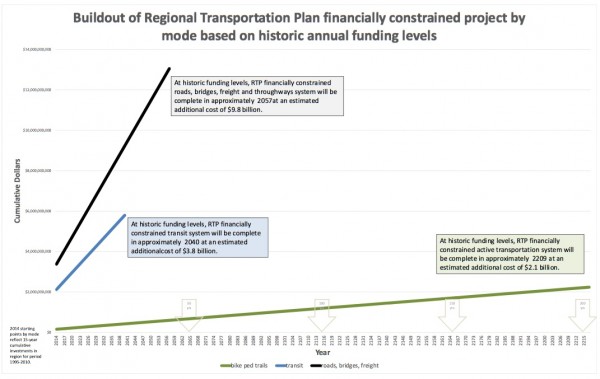
When The Oregonian asks whether Portland can possibly find $613 million over 30 years to build the bike plan that would turn it into an American Copenhagen, this is what it is (or isn’t) talking about.
When we wonder how it’s possible that 83 percent of U.S. trips still happen in cars at a time when federal taxpayers are spending $52 million to move 85 people off a Louisiana island that’s about to slip beneath the Gulf of Mexico, this is what we’re wondering about.
— Michael Andersen, (503) 333-7824 – michael@bikeportland.org
BikePortland can’t survive without subscribers. It’s just $10 per month and you can sign up in a few minutes.


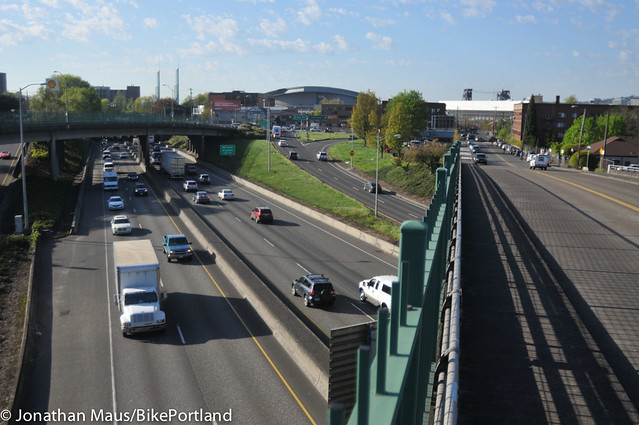
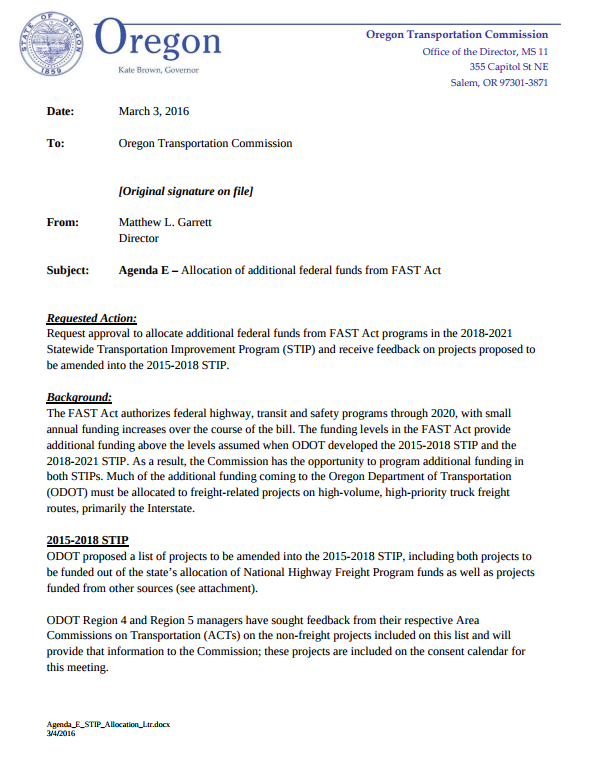


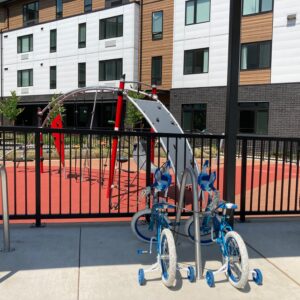
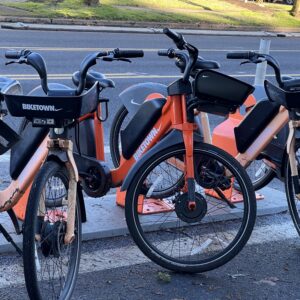

Thanks for reading.
BikePortland has served this community with independent community journalism since 2005. We rely on subscriptions from readers like you to survive. Your financial support is vital in keeping this valuable resource alive and well.
Please subscribe today to strengthen and expand our work.
This money did not drop into their laps from nowhere, every cent of that $196M is taxpayer money.
Of course we’ve known about it. Congress has been deadlocked for years, so the Federal gas tax funds have been accumulating; this is a sudden release of those funds, which was (quietly) reported by the general media a few months ago, just before the Iowa caucuses. Meanwhile, ODOT has been getting ready for these funds, as has PBOT as part of its TSP process. PBOT has been trying to tap into the “Fix-It” funds for years, which are normally used for interstate maintenance, but can now be legally used on city streets. Expect a fierce back-room battle between PBOT and ODOT in the next few months.
PBOT is just another applicant begging for ODOT’s active transportation scraps … they have no say in how this money is allocated
ODOT KNOWS
Now compare all these numbers with the total of farm subsidies and defense spending (at a national level). Commence crying. Sorry, there is no money for tissues. They’re on you.
This comes down to the gas tax formula which allocates 50% to ODOT, 30% to counties and 20% to cities formula that exists because it always has. The formula could change with political will
That’s from state gas taxes, yes? FAST was the result of Congressional and House revisions to Obama’s DRIVE Act, and it passed in the late hours of session wrap-up last year.
http://transportation.house.gov/news/documentsingle.aspx?DocumentID=399617
This is the federal political process at work. Just wait until they try to approve a Supreme Court nominee…
If I’m not mistaken, this ‘our’ chunk of it, in addition to TIGER grants:
http://www.fhwa.dot.gov/environment/transportation_alternatives
ODOT is also responsible for many more miles of roadway than PBoT, and there should probably be a discussion about how much of their money is spent on Portland area projects. Not sure why PBoT shouldn’t be made responsible for all the roads within its commerce boundary. Then we can know as a city just how expensive all those roads are.
This isn’t an argument against spending on small transportation projects; all the more reason to focus on them because of the returns they will yield. If induced demand is a real thing we should be building capacity for more efficient forms of transportation, saving us money in the long term.
I am saddened to see $49 million going to freight companies. I think these companies need to start building the cost of maintaining roadways drivable for over-sized vehicles into their business models. Forcing them to do so would inevitably drive up the cost of goods, but, it would also make local products much more competitive. Don’t we also want to encourage the local economy? Also, maybe we would have less money to pay in taxes meaning more money to spend on goods – paying out the front instead of the back pocket.
Wondering what “strategic investments” are.. I didn’t see a link that explains this. Any ideas?
The “Strategic investments” are Parking garages at convention centers as an alternative to mass transit.
Strategic Investments = Railroad infrastructure, especially bridges and flyways.
I’m sure there are many people in the public who might have appreciated more documentation and discussion of all these line items.
oh look, deep pockets!! gimme, gimme!!
And of the $196 million 90% will go to executive salaries to individuals that sit around cocktails attending MEETINGS! To decide where the remainder of the money goes.
That is unsubstantiated, unverifiable, rumor mongering nonsense. There are plenty of reasons to distrust the “leadership” class, but hurling lies is no way to address the issue.
is this satire of some sort?
I don’t understand what the category ” freight” is. Is that special new roads only for trucks? Or money to fix the curbs that trucks break up when they turn short? Or to put those little truck only lanes like the one on I5 near Tigard. Anyone know?
Daily bulldozer runs to clear all of the SOV congestion off of the freight routes.
Funds to remove bikelanes from SE 26th (now that PBOT’s effectively ceded it to ODOT) to make it “safer for bicyclists” (read: make it more convenient for freight transit). For example.
Providing only $5 million for “enhance” (safety/bike/ped) for the new STIP is a joke. It’s also a slap in the face of the local governments, non-profits and stakeholders who have highlighted ODOT’s backwards movement in their recent bike-ped plan. It’s time for ODOT and Governor Brown to wake the @#$% up and realize that 1950s era transportation priorities are not going to cut it in 2016. Matthew Garrett should be fired and replaced with someone who actually gives a @#$% about the future of our city and state.
I completely agree, and I also want to take this opportunity to apologize for ‘beating you up’ on this board sometimes. While we have many opposing ideas as to approaches and the means to the ends, I suspect we agree far more than disagree on the goals. I’m sorry, and I’ll work to improve my tone in the future. Really, I get just as frustrated as you at many of the same things. KTRSD!
Pete, ditto from me. My tone was also too divisive.
Hum, throw all of this into the bottomless pit of rural and interstate road maintenace, or give some to the two cities where 99.9% of all trips and economic activity in Oregon is generated?
I think we know how this ends.
Perhaps given the obvious institutional priorities embeded in the above budget we should remain ODOT one of the following since they don’t prioritize other forms of transportation:
Oregon Department of Cars and Trucks
Oregon Department of Gas Guzzlers and Oil Burners
Oregon Department of Climate Change Acceleration
Oregon Department of ” Shaft future generations so we can have happy motoring today”
Or Oregon Department of C02 production.
I’m waiting for Michael to throw race into this discussion just like he did with the housing discussion.
Jeez, man, not everything’s about race. 🙂
The emphasis on freight raises one’s eyebrows, especially now that most container traffic has been relegated to Seattle. Therefore this money can’t go anywhere but the freeway system. Funding biking / walking projects isn’t allowed. Therefore, the only thing this money is good for is to add lanes on I-5 and I-205. And that’s disappointing, to say the least! That money really should go to expanding our ped / bike trail network. But it won’t, because the Feds say so. And if the R’s win the election, any chance of getting federal help to create such an expansion will be dead for at least another decade. Maybe more.
Just <3% of the funds proposed directly for ADA ramps and accessibility…seems paltry given the aging society and the lack of transit in many areas dependant on ODOT facilities…please someone pull out the ODoTs ADA Transition Plan and see how well this addresses that shortcoming as is federally mandated for completion…
ODOT’s $196 million? Then fix crash corner in Raleigh Hills.
Not that the areas to which ODOT is planning to allocate the money aren’t justified, but an increase in priority of biking and walking projects seems in order. Out here in Beaverton, even I can see the consequences of the growing populations’ travel needs not being met by the long standing approaches of road widening for increased motor vehicle use.
More of a commitment, and not just in terms of money, needs to be made towards improving walking and biking infrastructure in cities, so those modes of travel are at least an option, whether or not people readily come to use it. Logic suggests that one of the reasons freight has so much difficulty making connections, is that routes it needs to make its’ deliveries, are excessively occupied by non-freight people lacking sufficient alternatives closer to home.
The two major highways, Canyon rd-TV Highway, and Beav-Hillsdale Hwy, running straight through Beaverton, are a classic example. Those highways aren’t just Beaverton streets used mostly by residents of the city, but routes used by freight, plus everyone and their kids and dogs, people outside of the city passing through on their way to work elsewhere.
There’s really little way those highways realistically can be widened to more efficiently handle freight transport. Beaverton having greater help improving its active transportation infrastructure, would at least hold the possibility of getting some of its citizens off the routes freight has a dire dependence on.
Why is this a surprise? This is exactly how government works.
My favorite is ‘strategic investments’
I wonder who’s pocket that represents